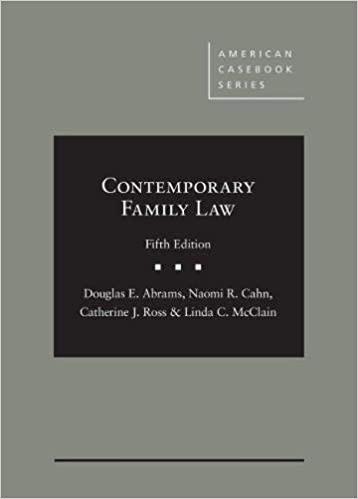Question
Conti v. American Society for Prevention of Cruelty to Animals, 353 NYS 2d 288 (1974) Chester is a parrot. He is fourteen inches tall, with
Conti v. American Society for Prevention of Cruelty to Animals, 353 NYS 2d 288 (1974)
Chester is a parrot. He is fourteen inches tall, with a green coat, yellow head and an orange streak on his wings. Red splashes cover his left shoulder. Chester is a show parrot, used by the defendant ASPCA in various educational exhibitions presented to groups of children. On June 28, 1973, during an exhibition in Kings Point, New York, Chester flew the coop and found refuge in the tallest tree he could find. For seven hours the defendant sought to retrieve Chester. Ladders proved to be too short. Offers of food were steadfastly ignored. With the approach of darkness, search efforts were discontinued. A return to the area on the next morning revealed that Chester was gone. 13
On July 5th, 1973 the plaintiff, who resides in Belle Harbor, Queens County, had occasion to see a green-hued parrot with a yellow head and red splashes seated in his backyard. His offer of food was eagerly accepted by the bird. This was repeated on three occasions each day for a period of two weeks. This display of human kindness was rewarded by the parrot's finally entering the plaintiff's home, where he was placed in a cage. The next day, the plaintiff phoned the defendant ASPCA and requested advice as to the care of a parrot he had found. Thereupon the defendant sent two representatives to the plaintiff's home. Upon examination, they claimed that it was the missing parrot, Chester, and removed it from the plaintiff's home. Upon refusal of the defendant ASPCA to return the bird, the plaintiff now brings this action in replevin. 14
The issues presented to the Court are twofold: One, is the parrot in question truly Chester, the missing bird? Two, if it is in fact Chester, who is entitled to its ownership? The representatives of the defendant ASPCA were categorical in their testimony that the parrot was indeed Chester, that he was unique because of his size, color and habits. They claimed that Chester said 'hello' and could dangle by his legs. During the entire trial the Court had the parrot under close scrutiny, but at no time did it exhibit any of these characteristics. The Court called upon the parrot to indicate by name or other mannerism an affinity to either of the claimed owners. Alas, the parrot stood mute. 15
Upon all the credible evidence the Court does find as a fact that the parrot in question is indeed Chester and is the same parrot which escaped from the possession of the ASPCA on June 28, 1973. The law is well settled that the true owner of lost property is entitled to the return thereof as against any person finding same. (In re Wright's Estate, 15 Misc.2d 225, 177 N.Y.S.2d 410) (36A C.J.S. Finding Lost Goods s 3). This general rule is not applicable when the property lost is an animal. In such cases the Court must inquire as to whether the animal was domesticated or ferae naturae (wild). Where an animal is wild, its owner can only acquire a qualified right of property which is wholly lost when it escapes from its captor with no intention of returning. Therefore, the issue is simply whether Chester was domesticated or wild. 16
In Amory v. Flyn, 10 Johns.(N.Y.) 102, plaintiff sought to recover geese of the wild variety which had strayed from the owner. In granting judgment to the plaintiff, the court pointed out that the geese had been tamed by the plaintiff and therefore were unable to regain their natural liberty. This important distinction was also demonstrated in Manning v. Mitcherson, 69 Ga. 447, 450451, 52 A.L.R. 1063, where the plaintiff sought the return of a pet canary. In holding for the plaintiff the court stated 'To say that if one has a canary bird, mocking bird, parrot, or any other bird so kept, and it should accidentally escape from its cage to the street, or to a neighboring house, that the first person who caught it would be its owner is wholly at variance with all our views of right and justice.' The Court finds that Chester was a domesticated animal, subject to training and discipline. 17
Thus, the rule of ferae naturae does not prevail and the defendant as true owner is entitled to regain possession. The Court wishes to commend the plaintiff for his acts of kindness and compassion to the parrot during the period that it was lost and was gratified to receive the defendant's assurance that the first parrot available would be offered to the plaintiff for adoption. Judgment for defendant dismissing the complaint without costs. 18
Answer These Questions: 1. What are the material facts? 2. What is the procedural history? 3. What rule(s) is the court applying? 4. What rules does the court synthesize? Use this format: "The true owner of lost property is . . . unless . . . but" 5. What is the legal issue?
Step by Step Solution
There are 3 Steps involved in it
Step: 1

Get Instant Access to Expert-Tailored Solutions
See step-by-step solutions with expert insights and AI powered tools for academic success
Step: 2

Step: 3

Ace Your Homework with AI
Get the answers you need in no time with our AI-driven, step-by-step assistance
Get Started


